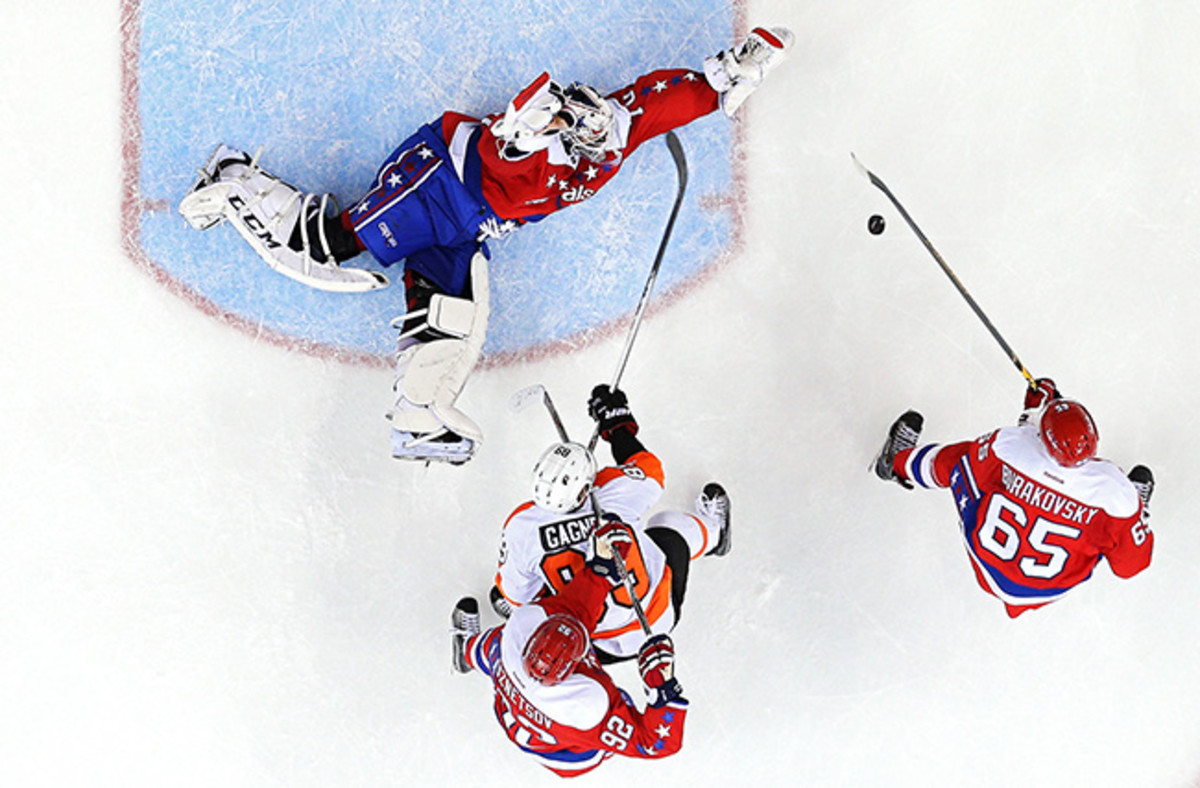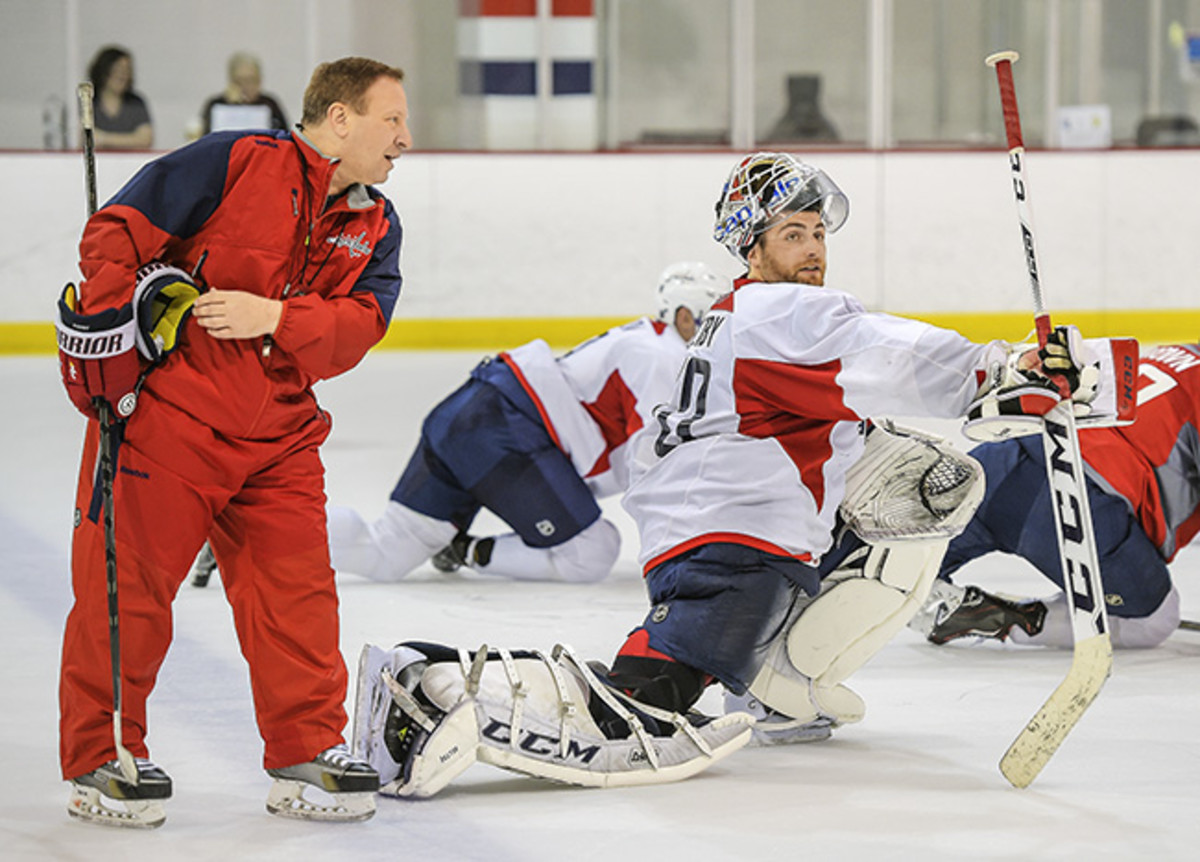Goalie Braden Holtby Has Capitals Thinking Stanley Cup


Farmboy leaves home, meets a guru, and masters a power he never knew he had. It's the plot of countless movies — Star Wars, Lord of the Rings, Kung Fu Panda — not to mention the story of Braden Holtby, the Washington Capitals 26-year-old netminder and the front-runner for this year's Vezina Trophy, given to the NHL's best goalie.
Holtby left his family's farm in Marshall, Saskatchewan in 2005 as an unheralded teenage prospect and has since overcome long odds to become the most important player on the NHL's most dominant team. With a .924 save percentage and a league-leading 38 wins through Feb. 23, Holtby has made the Capitals a Stanley Cup favorite.
How does he do it? Ask Washington's goaltending coach Mitch Korn and he might call it order: Holtby's game is like a carefully assembled thousand-piece jigsaw puzzle. Or he might cite Holtby's ability to adapt on the fly, like a driver jumping into a new car in the middle of the Indianapolis 500.
Capitals coach Barry Trotz calls Korn "Yoda." But Korn compares his relationship with his protege to another movie: Back to the Future. Don't worry: He can explain.
BIDING HIS TIME
When Washington selected Holtby in the fourth round of the 2008 draft, he faced a steep climb up the depth chart. In the 2006 draft, the Caps had used two high picks on netminders: SemyonVarlamov (23rd) and Michal Neuvirth (34th).
While Holtby was still playing in Saskatoon during 2008--09, those two made their debuts at just 20 years old. Many thought Washington had their goaltending duo of the future. Holtby, however, still saw an opening. "I thought it was a great opportunity for me because there was no one there that was signed to a long-term deal," Holtby says.
After an uneven season in the minors, Holtby joined the Capitals in March 2012 and played well in seven games (4-2-1). Then, at the start of the postseason, both of Washington's usual goalies, Neuvirth and veteran Tomas Vokoun were out with injuries. (Varlamov had been traded to the Colorado Avalanche before the season.)
Suddenly, the then 22-year-old Holtby, with just 18 career NHL starts, found himself in goal against the defending champion, the Boston Bruins. The first two games of the series went to overtime and the rookie was brilliant, allowing just two goals on a combined 74 shots. Even though Neuvirth seemed healthy by Game 3, Washington coach Dale Hunter flatly stated, "Holtsy's our goalie."
Holtby rewarded Hunter's faith by leading the Caps to a series win in seven games. Although his team would ultimately lose in Game 7 of the next round against the Rangers, Holtby was still dominant (.935 save percentage). His playoff run earned him the starting gig during next year's lockout-shortened season.
In 2013--14, Holtby's first full NHL campaign, the Caps went 38-30-14 and missed the playoffs. Second-year coach Adam Oates took the fall, and the team hired longtime Nashville coach Barry Trotz, who brought Korn with him. Luckily, Holtby had some idea of what was coming.

DOC AND HOLTBY
While with the Predators during the 2004-05 NHL lockout, Korn attended a goalie camp in Edmonton for major junior players and met a fellow instructor named John Stevenson.
In NHL circles, Korn is known for his exotic training techniques and the amazing results he gets with them. While working for the Buffalo Sabres from 1991 to '97, he coached future Hall of Famer DominikHasek during arguably the greatest stretch any goaltender has ever had (Hasek won four Vezina Trophies and two Hart Trophies, given to the NHL's best player). In Nashville, Korn helped late-round picks Tomas Vokoun and PekkaRinne rise to stardom. And he did all that with props.
Among the wacky tools advertised on his website, Korn employs a bungee ball that connects to a goalie's glove hand (it allows him to work on catching all by himself), white pucks (they encourage tracking), mini-pucks (they force the player to close holes), and a mesh hood that goes over the goalies' mask (it hones vision).
He introduced some of these tools, and the drills in which he uses them, to Stevenson, who in turn taught them to a teenage Braden Holtby a few years later in Saskatoon. That's where the movie analogy comes in.
"I joke that it's like the movie Back to the Future," Korn says. "I knew I was going to Washington, so I went back in my DeLorean — well it's a Camry — and went to 2004, purposefully met John Stevenson so I could introduce him [to my drills] so he could introduce [them to] Braden. So when we got to 2014 he would be ready."
Except when it came to 2014, things weren't going as smoothly as planned. Holtby struggled for the first two months under Korn. The reverence built up for his new coach during his younger days, however, eventually helped him buy into Korn's teachings.
"Growing up, Mitch was the guy that was idolized in the goaltending community I was in," Holtby says. "He was the guy behind creating everything. I was extremely excited to work with him. It was a perfect time in my career, because I was excited to just prove I could play, get better."
Holtby did more than just prove he could play. Since those tough first two months, Holtby leads all NHL goaltenders in games played (117), wins (77), and shutouts (11).
Korn and Holtby both attribute this success to increased body control. Holtby has been able to tighten up his movement in net, "filling up the holes" he used to create for opposing shooters.
So what's next for Holtby, now that he's playing so well? Korn has an analogy for that too. Although he likens his work with Holtby to trying to get a 400-pound person to lose weight, he believes last season's improvement was extraordinary, like losing those first 150 pounds. This season's goal? Shedding 50 more. Compared to time travel, how hard can that be?
Photos: Patrick Smith Getty Images (action), John McDonnell/The Washington Post/Getty Images (practice)
